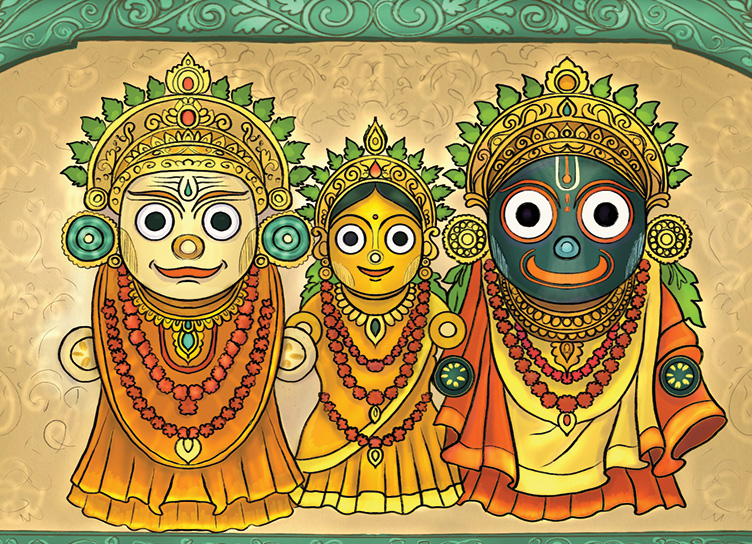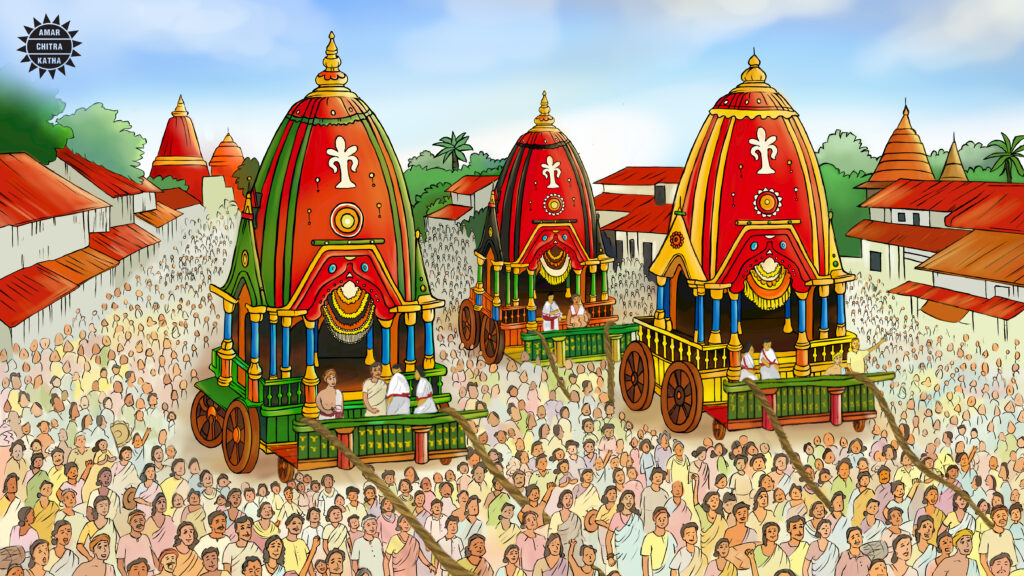The Jagannath Rath Yatra
- June 26, 2025


The Jagannath Rath Yatra
- June 26, 2025
by Shree Sauparnika V
In the sacred town of Puri, a festival unfolds each year that draws millions to its streets and millions more in prayer. It is a celebration of devotion, tradition, and the bond between the divine and the devotee. Ancient in its origins and grand in its scale, it is one of the most cherished festivals in India. This is the Jagannath Rath Yatra.
The words ‘Rath Yatra’ simply mean ‘chariot procession’. But the scale of this yatra is anything but simple. It involves three giant, hand-carved wooden chariots, each more than 40 feet tall, built afresh every year for Lord Jagannath, his elder brother Balabhadra, and his sister Subhadra.
To receive more such stories in your Inbox & WhatsApp, Please share your Email and Mobile number.

On the day of the yatra, celebrated in the Hindu month of Ashadha (June–July), these deities leave their grand abode, the Jagannath Temple, and travel to their aunt’s temple, the Gundicha Temple, about three kilometers away. The streets of Puri transform into a living river of people, pulling the ropes of these majestic chariots, singing devotional songs, and celebrating what is to them, the most divine road trip of the year.
Different kinds of Sevakas or helpers, from the Jagannatha Temple offer their services; the most important among them being the Suara Mahasura Dahuka; a couple of charioteers who recite what is known as the Dahuka Boli, which are essentially bawdy songs. The lyrics of the Dahuka Boli tend to be very risqué, with a lot of double entendre. Since it is believed that the Rath Yatra is a symbol of fertility and the cycle of life; unless the Dahuka Boli is sung, the Rath Yatra does not start.
The Rath Yatra has been celebrated for over a thousand years, with records tracing it back to the 12th century, when the Jagannath Temple itself was built by King Anantavarman Chodaganga Deva. Since then, the chariots have rolled through the streets of Puri every year without fail, watched over by generations of kings, pilgrims, and priests. But the legend of King Purushottama Deva, who ruled Odisha in the 15th century, adds a stirring and dramatic chapter to the festival’s legacy.
According to the famous Kanchi-Kaveri legend, King Purushottama Deva once sent a marriage proposal to the princess of the powerful Kanchi kingdom in the south. However, the Kanchi king rejected the proposal, mocking that Purushottama, despite being a ruler, had humiliated himself by sweeping the chariot path of Lord Jagannath during the Rath Yatra. To the devout Odia king, this was no humiliation, but the highest honour—serving the Lord as his humble devotee.
Feeling insulted, Purushottama vowed to teach the king of Kanchi a lesson. He launched a military campaign against Kanchi, but his first attempt failed. On returning to Puri, he prayed to Lord Jagannath and sought his blessings for a second expedition.
This time, before setting out, the king declared that Jagannath and Balabhadra themselves would lead the army. As the story goes, during the march, two mysterious warriors—one dark and one fair—were seen riding ahead of the Odia forces. They stopped at the house of a cowherd woman and asked for curd-rice. She offered them food, unaware of their divine identities. When the king arrived later and heard her account, he was deeply moved and realised that the Lord and his brother had truly gone ahead to bless the battle.
This time, the Odia army triumphed over Kanchi. The princess, moved by the divine tale and the king’s devotion, agreed to marry him. As a tribute to Lord Jagannath, Purushottama Deva brought her back to Puri and arranged for the royal wedding to be held in the presence of the deities.
Since then, the Kanchi-Kaveri story has been celebrated in Odia lore as a shining example of divine intervention, royal devotion, and victory of dharma. It also highlights the sacred bond between Lord Jagannath and the kings of Odisha, where even monarchs see themselves as mere servants of the Lord.
One particularly sweet belief is that the Lord goes out on this Yatra so that his devotees, who are not allowed into the main temple (non-Hindus, for instance), get to see him during this public procession. It is a festival of inclusion, where every devotee, no matter where they’re from, gets darshan.
Preparations for the Rath Yatra begin months in advance. Special logs of wood are brought from select forests to build the chariots. The colours of each chariot are symbolic—red and yellow for Subhadra, red and green for Balabhadra, and red and blue for Jagannath. The entire event is orchestrated with clockwork precision, yet it holds the chaotic energy of a divine carnival.

The pulling of the chariots is the high point. Thousands gather to hold the ropes—because it is said that pulling the Lord’s chariot washes away one’s sins and brings good fortune. The procession takes several hours, sometimes an entire day, and ends with the deities resting at the Gundicha Temple for nine days before returning to their sanctum.
For centuries, the Jagannath Rath Yatra has reminded devotees that the divine is never distant. It is a festival of faith, humility, and shared joy. As the chariots roll through the streets of Puri, they carry with them the prayers of a people and the grace of a tradition that continues, year after year. As the Lord sets out on his journey, devotees find meaning in their own.
Read more about the Ancient Temples of India in our ACK Comics App.
To receive more such stories in your Inbox & WhatsApp, Please share your Email and Mobile number.

Comic of The Month
The Naval Journey of India Book I
This book is the first of a three-book series that takes a deep and detailed look at India's Naval History and a deep insight into the lives of our men and women in white. But any series on the Indian Navy has to start at the very beginning - exploring India's celebrated maritime history. Join our little hero, Bharat, and his grandfather, Commodore Sagar, as they sail into the deep blue waters of time. Book I of The Naval Journey of India takes a sweeping look at India's maritime endeavours, how the seas impacted us over millennia and how the oceans made us who we are.